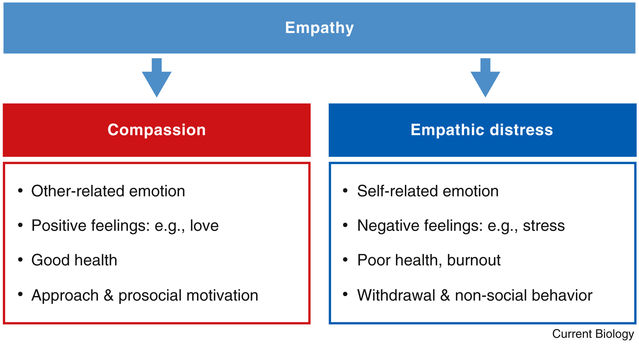Empathy
Turn Empathy Into Compassion Without the Empathic Distress
Research shows ways to avoid empathy's pitfalls while remaining altruistic.
Updated November 7, 2023 Reviewed by Matt Huston

“If you want others to be happy, practice compassion. If you want to be happy, practice compassion.”—Dalai Lama
I recently watched the movie Harriet, detailing the heroic life of abolitionist Harriet Tubman. While the film was moving and inspiring, there were times I felt overwhelmed by emotion to the point of discomfort. I’ve tried to increase my empathy for others over the years, though frequently mirroring the negative emotions of others can become distressing.
What Empathy Is and Why It’s Important
Empathy has become a popular topic in recent years, and over 1,500 books on Amazon have empathy in their title or subtitle. And for good reason. As trauma expert Bruce Perry said in his book, Born for Love: Why Empathy Is Essential—and Endangered, “Empathy underlies virtually everything that makes society work—like trust, altruism, collaboration, love, charity. Failure to empathize is a key part of most social problems—crime, violence, war, racism, child abuse, and inequity, to name just a few.”
Empathy is an umbrella term, which broadly involves sensitivity to others’ feelings. Psychologists distinguish between two types:
-
Cognitive empathy. Also known as mentalizing or perspective-taking, this type of empathy involves consciously adopting another’s perspective and trying to understand how they are feeling or thinking. When I accurately identified the emotions experienced by Harriet in the movie, I demonstrated cognitive empathy.
-
Affective empathy. Also known as emotional empathy, emotion contagion, vicarious experience, or empathic sharing, affective empathy entails feeling elements of another person’s emotions. This somewhat automatic process involves mimicry, where another’s expression or demeanor is mirrored. When I mimicked Harriet’s grief at the death of her friend, I showed affective empathy.
Empathy is associated with many positive outcomes, including improved romantic relationship satisfaction and increased levels of trust between patients and physicians. It is also a precursor to prosocial behavior. The lack thereof has been associated with bullying, aggression, and criminality.
Drawbacks of Empathy
While the benefits of empathy are clear, humans are much more likely to empathize with people they view as a part of their in-group. We are prone to create groups of us versus them. For example, neuroscience researchers have found that people experience greater vicarious empathic responses for people of their own ethnicity compared to other-ethnicity members.

The division of us and them can be based on trivial things. Using fMRI, researchers found greater activation in brain areas associated with empathy (left anterior insula) when participants viewed members of the same sports team receiving pain compared to those from another sports team.
In one series of experiments, soccer fans were reminded of their love for their team, then passed by a person in distress who wore either a shirt supporting the same soccer team, a shirt supporting a rival team, or a plain shirt. Participants helped those wearing a shirt in support of the same team the most, then someone in a plain shirt, and helped those wearing a shirt supporting the rival team the least.
Empathy not only can intensify in-group bias, but also has the potential to become empathic distress. This was described by Tania Singer and Olga Klimecki as “a strong aversive and self-oriented response to the suffering of others, accompanied by the desire to withdraw from a situation in order to protect oneself from excessive negative feelings.”
When I watched Harriet Tubman encounter hardship and death in the movie Harriet, I felt distressed. I wanted to turn away from her pain. Unfortunately, prolonged distress causes many in helping professions, such as doctors, nurses, and counselors, to burn out, endangering their own physical and mental health. Those experiencing empathic distress have increased risk for depression, anxiety, lack of understanding and compassion for those they are responsible for, and many other physical and mental symptoms.
Empathy Versus Compassion
While empathy involves catching a wide range of emotions from others, compassion is specifically a feeling of concern for someone who is suffering, coupled with a desire to alleviate that suffering. As stated in The Oxford Handbook of Compassion Science, “While affective empathy may be considered a catalyst to feeling compassion, affective empathy does not guarantee, nor is it sufficient to engender, compassion (p. 26).”
Researchers Robert Eres and Pascal Molenberghs stated,
Without an emotion regulative network, shared emotional states may inhibit our ability to perform tasks that require emotional distance (e.g., a surgeon operating on a child or a defense lawyer supporting a psychopath) … Essentially, there needs to be a neural function that inhibits or facilitates empathic responses more explicitly to allow for appropriate functioning in day-to-day life.
Compassion may act as part of that emotion regulative network.
Feelings of compassion are at odds with empathic distress. When someone feels compassionate, the feeling is other-focused, positive, and protects against burnout (see the image below, from here). While affective empathy involves taking on the negative emotions of others, compassion invites feelings of love and warmth toward others, preventing the desire to abandon those who are suffering.

How to Transform Empathy Into Compassion
Moving away from empathic distress and toward compassion involves compassion training, wherein psychologists use meditation-related techniques to foster feelings of generosity and kindness. Typically, this form of mental practice is carried out in silence as one visualizes a person they feel close to, themselves, a neutral person, an enemy, and then expands to all of humanity. At each stage, the person is wished love, kindness, and freedom from suffering.
This training has been shown to increase positive affect and well-being during everyday life. Singer and Klimecki found, “the amount of time participants practiced compassion predicted how much a certain type of helping behavior increased, namely pure altruistic helping as opposed to reciprocity-based helping. This indicates that compassion training especially increases prosocial motivation rather than just norm-adherence.”
When Singer and Klimecki randomly assigned participants to receive either empathy training or compassion training, those who used empathy training had greater activation in the insula and anterior middle cingulate cortex, areas associated with vicariously feeling the suffering of others. However, those who were trained in compassion showed activation in the medial orbitofrontal cortex and ventral striatum, areas associated with vicarious pleasant touch and shared social rewards.

Those who experienced compassion training reported more positive emotions than those in the empathy training group. This was true for me while watching the suffering of those in the movie Harriet. When I tried to take on their grief, I was overwhelmed. However, when I shifted my focus to feel love and kindness toward the characters, with a wish that their suffering would be alleviated, my distress for them was replaced with a feeling of inspiration.
While empathy is susceptible to in-group bias, compassion meditation seeks to expand one’s in-group. In the study about soccer fans mentioned earlier, researchers found that reminding participants of their love for soccer, not just their specific team, increased helping rates toward the rival team. Similar results were found in Australia where reminding students of a common Australian identity increased helping behavior toward indigenous Australians.
It seems, then, that one’s perceived in-group can be manipulated and expanded using small cues, and practicing compassion meditation may help. The secret to genuine caring and altruism lies within compassion, not affective empathy.




